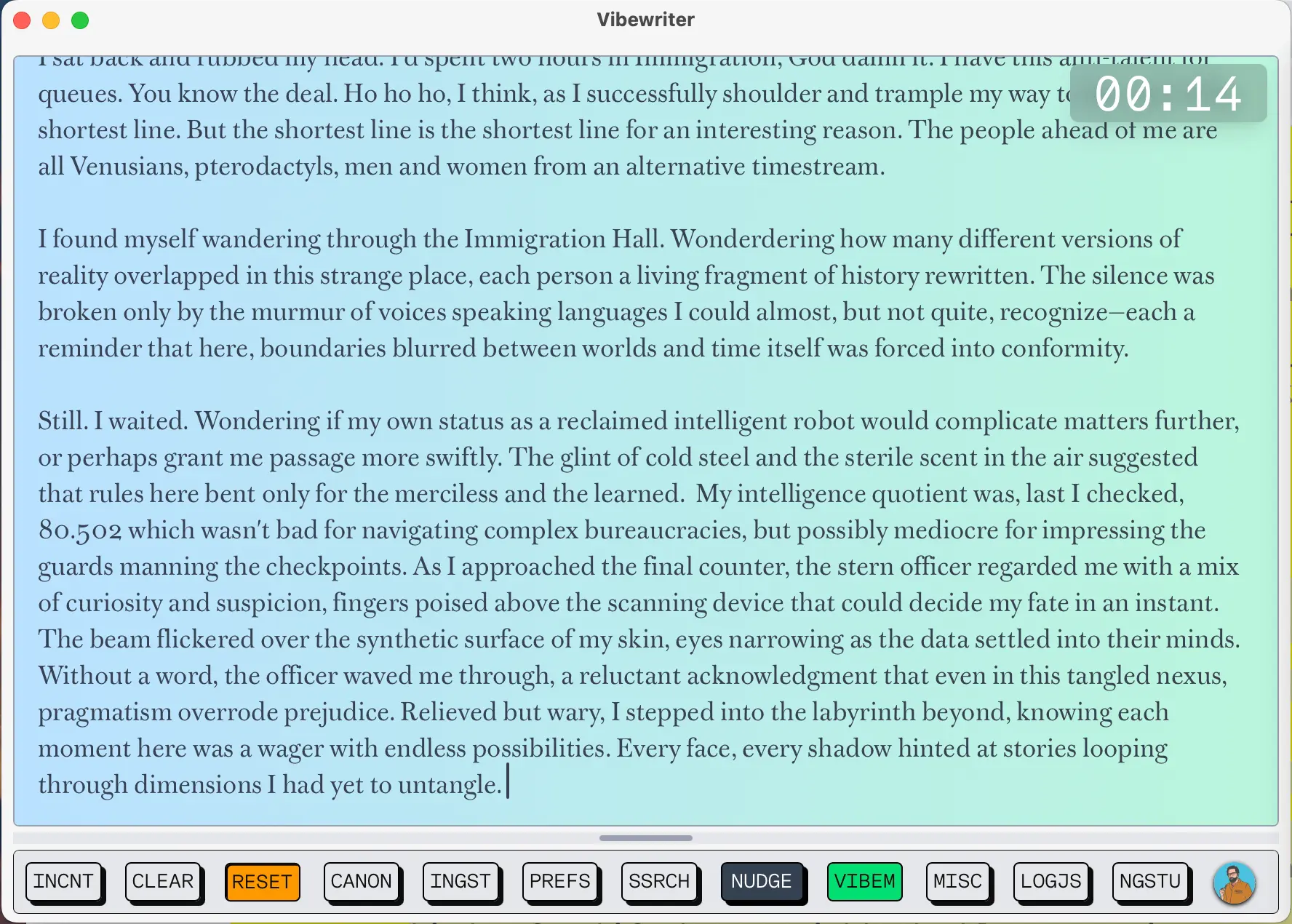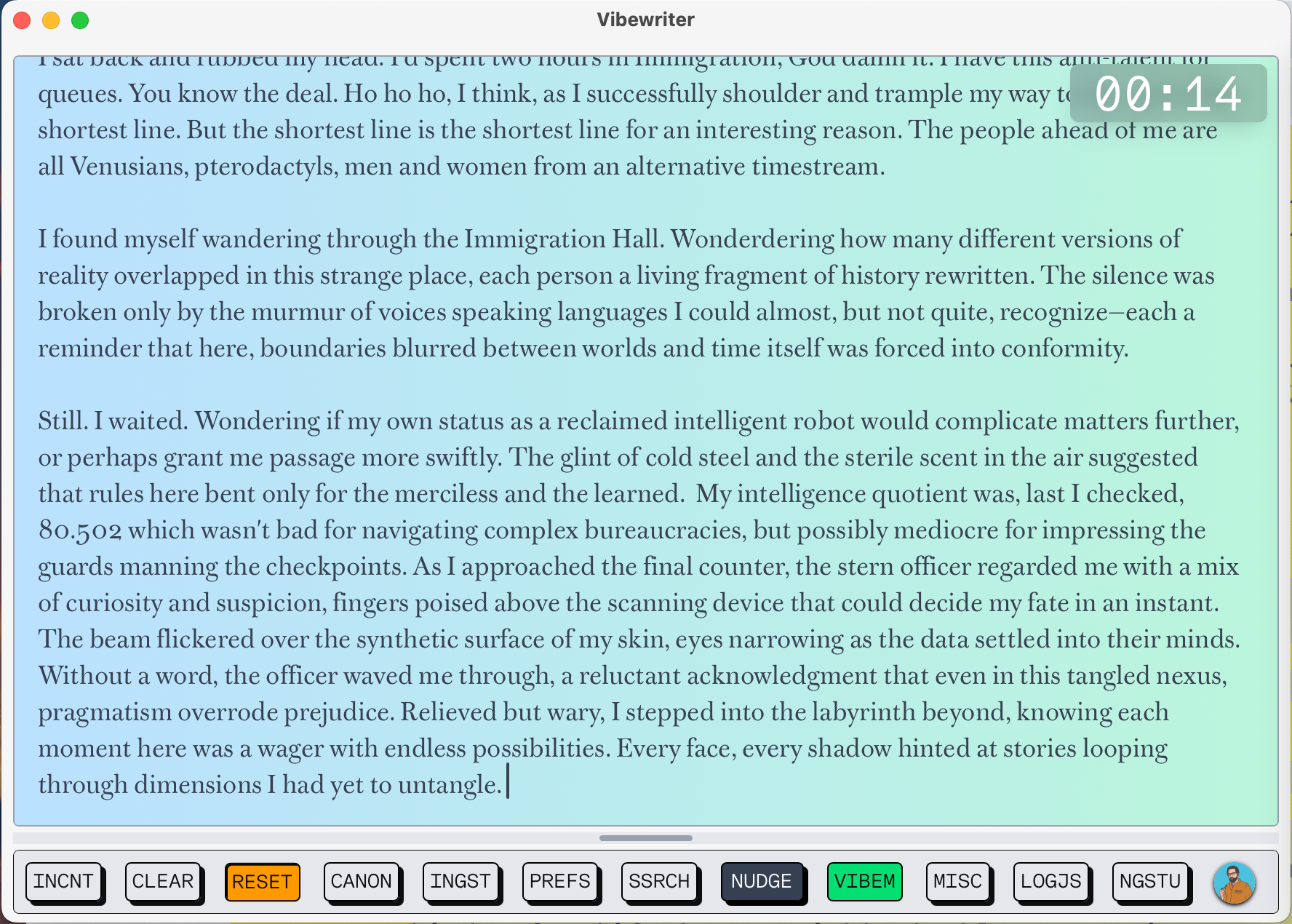
Project Summary
VibeWriter is a Near Future Laboratory Design Fiction Project Sprint that evolved from the Ghostwriter project focussed specifically on an action-oriented writing instrument where there were varied game mechanics associated with the writing in a way that facilitated less pondering and more articulating of ideas in text. A bit like a surrealist tablet that encouraged stream of consciousness and just getting ideas out on "the page"'
VibeWriter is a bit of a 'Fork' of the main Ghostwriter code base that pits the human and its AI partner against the clock.
When the clock runs down, the AI partner is there to help you finish your thought, or at least get you to the next sentence.
Project Semantic Tags
ARTIFACTCODINGDESIGN SPRINTDESKTOPFUNCTIONALJAVASCRIPTLESS YAMMERING MORE HAMMERINGPROGRAMMINGRUSTSOFTWARESPECULATIVE PROTOTYPETAURIUXUX DESIGN
The Outcomes
About 10 hours to cobble together a fully-functional artifact building on the Ghostwriter functional software design study. This is a study in building speculative software prototypes from a plausible Near Future. A way to experiment with new opportunities, scratch creative itches, and consider an adjacent mode of UX design beyond the canonical ‘chat’ interface. Developed using Tauri, Rust, OpenAI, Ollama, LM Studio, Postman, Vanilla Javascript and a bunch of imagination.
This..is about wrestling [the tools] into alignment with what we find sacred or essential. We won’t find salvation by escaping technology, but by using our..capacity for critique, ritual, [and] invention.. The saving power is..to ask: “What space remains for meaning? For art? For wildness, chance, suffering, and genuine encounter?”
AI is not inevitable fate. It is an invitation to wake up. The work is to keep dragging what is singular, poetic, and profoundly alive back into focus, despite all pressures to automate it away.
Motivation
The success of GitHub Copilot in “completion” mode stems from its quiet brilliance: it helps you work faster without getting in the way. As developers writing code type, Copilot emanates completions allowing developers to stay in flow, stay in context, and not get hung up with forgettable or terse syntax. It’s a completion engine that helps you write code faster, more accurately, and with less friction. (Ignoring for a moment more extensive capabilities in Copilot Chat mode.)
Most AI writing tools have taken the path of the chatbot paradigm.
Question ➭ Answer.
Question ➭ Answer.
For the prose-based writer, one must stop, prompt, and converse with a bot that exists slightly outside their workflow.
As a recent essay in The New Yorker have shown, this model can feel awkward, artificial, and even creatively disruptive.
In her piece “Can AI Writing Be More Than a Gimmick?”, Vauhini Vara reflects on the limitations of current AI tools for writers. Her early experiments with GPT-3 revealed something profound: the most powerful interactions were not conversations — they were completions. Fragments that supported her, suggested paths forward, or simply nudged her through the blank page.
— The New Yorker
Background: Introducing Vibewriter — the Vibe Mode of Ghostwriter
Ghostwriter is an experimental writing assistant inspired by GitHub Copilot — built for prose-based completion.
Recently, while preparing for a workshop on AI, I was developing some contributing and motivating artifacts that were meant to help participants get a sense of the future of AI.
One of these artifacts was an issue of a ‘newspaper from an AI future’.
I was writing the prose-based text of the articles using VisualStudio Code as a simple text editor. As ideas for articles I had Copilot installed and had been using it routinely for programming tasks. I was quite surprised that it began to emanate text somewhat semantically consistent with the fictional news articles I was writing. It was like having a ghostwriter or muse sitting next to me in the form of a robust text completion engine.
On the way back from the workshop I was thinking about how Copilot had been so useful in this context. I began to wonder if there was a way to create a creative or prose-based writing assistant that would be more like Copilot than the current generation of chatbots, and the years-old crop of AI-based writing applications.
I began to sketch out some ideas for a tool that would be more like a ‘Copilot…But for Writing’ — something that would work alongside of the writer more like a muse, providing what Rick Rubin refers to in his book oft-cited book “The Creative Act” as ‘The Source’: that thing from which ideas are generated.

It provides a configurable countdown timer, upon whose expiry VibeWriter then takes over and emanates its contribution, typing out a continuation of the text with inspired and evocative semantic consistency.
Can a tool be developed that helps maintain flow state and momentum for writers that does not overwhelm with features and options? A tool that does not feel like a complicated software application, but a source of inspiration that lightly and gently nudges the writer along? Providing flow and fuel without friction? A cure for writers’ block?
I developed a few quick prototypes — one a VS Code plugin.
Another a simple web-based text editor.
A desktop application that uses a RAG-based context pipeline.
I have been experimenting and using it in a variety of contexts to see how it might provide genuine value to the writing process.
I am looking for support and collaboration from partners to continue this development with the ultimate goal to have a metamodern writing assistant for creative writing.
Provides in-line, context-aware completions as you write
Responds to the tone, structure, and rhythm of the draft
Stays in the document, not in a separate chat box
Helps authors push through difficult moments, explore style, or simply find the next sentence
It’s not trying to write for you. It writes with you.
It’s not a chatbot. It’s a completion engine.
It’s not a tool. It’s a partner.
It’s not a distraction. It’s a collaborator.
It’s not a gimmick. It’s a muse.
What would a writing instrument look like in the imminent future—a world where companion intelligence (ranging from basic to premium) becomes as commonplace as wheeled luggage or breakfast cereal?
Rather than creating another passive tool like a typewriter or word processor with its blank page and blinking cursor, we envisioned something different: an active participant in the writing process. Not in the conventional, utilitarian way we see in many current AI writing tools, nor as merely a tool to organize thoughts or interface with source material (the now-common "chat with your PDF" approach).
We wanted to explore a world where AI functions more as a muse, a collaborator—a true partner in the creative dance of words and ideas. This exploration aligns with our mission at Near Future Laboratory.
VibeWriter emerged from a 10-hour Near Future Laboratory Design Fiction Project Sprint. Evolving from our earlier Ghostwriter project, it focuses specifically on action-oriented writing with game-like mechanics that encourage less deliberation and more active idea articulation—similar to a surrealist tablet that promotes stream-of-consciousness writing.
Our goal was to build something that works—a functional design fiction. This approach represents design fiction as product design or R&D: an Adventure Lab exploring the frontier of possibilities, creating meaningful artifacts that may not fit completely within today's paradigms but function at the edge of what's possible.
So I wondered to myself: Could I quickly create a writing tool to get into this. Somethign that was a genuinely functional artifact, not just a conceptual prop—imbued with AI that serves as a collaborator, partner, muse, and companion?
Vibecoding appears to be emerging as a concept, and while immersed in coding with GitHub Copilot and various assistants, I've been considering how the writing experience could become more like dancing with a muse (or what Rick Rubin calls "The Source") and less like trudging through a swamp of fragmented ideas.
Similar to how Vibecoding seems based on intuition, feeling, and rhythm, I've been exploring how to make writing more of a "vibe move" with gamified elements.
While developing Ghostwriter, I imagined incorporating a "curious" mechanic—perhaps a countdown timer reminiscent of 1980s game shows, where you must respond before time expires. This raised interesting questions: What constitutes a "response"? Completing a sentence? Writing 100 words? And what happens if one doesn't respond adequately?
The home-built AI component of Ghostwriter was enjoyable to create, code, and train. As development progressed, the idea of adding this time-pressure feature remained in the back of my mind—a "shot clock" (inspired by a recent Clippers game) for writing.
Want to get in on the beta test? Join the Patreon!
The Artificial Intelligence Designed Fictions Prototyping Studio is a prototyping-based design research program through Near Future Laboratory that explores the potential of artificial intelligence in the context of everyday life.
We are accepting commercial support, corporate or organizational sponsors, and incubation opportunities. To learn more about participating let’s connect..
The research program studies artificial intelligence through the creation of speculative design prototypes. These are meant to explore the potential of artificial intelligence in the context of everyday life.
The focus of the program is on rapid ideation and prototyping. We create small, functional artifacts that help ground possibilities in materiality and interaction. The speculative prototypes are also meant to be evocative and thought-provoking, like generative windows into future opportunities, focused on the practice of everyday life in a world in which we cohabitate, collaborate, and cooperate with a new kind of intelligent species.
Our thesis is that speculative prototyping in an expansive and experimental fashion is the way to discover new opportunities for this next phase of human consciousness. We will explore new kinds of interactions, services, artifacts, and objects as if we are entering a new territory for which the old modalities and assumptions are like ancient epistemologies and ontologies ill-suited for this new land.
In true Design Fiction style, there is the prototype of the artifact itself, but also the worldbuilding material that surrounds it. This research program prototypes in the traditional engineering sense, certainly. But we also create artifacts that are additive to the engineering prototypes and allow the studio to explore the cultural, social, economic, policy, and governance qualities of possible futures.
Clippings from newspapers. Magazine articles. Tourists guides. Social media posts. Receipts. The contents of a found wallet. Advertisements from streetware brands. Paperback self-help books. Podcast episodes. Oracular card games. Movie tickets. Etcetera.
These remanants of an inhabited future world help imagine into possibilities in a rich and textured way. The remants are like working backwards towards technological possibilities by exhibiting their cultural and policy-based effects in a more general and recognizable format
Unique to futures design studios, I not only help you with strategic reflections and considerations on technological and socio-technical futures. Near Future Laboratory is a laboratory in the trad sense of the word: I actually build things from the future — that actual work.
This and other functional futures prototypes are a unique proposition that I offer that most other futures design consults do not.
Industry experience and academic credentials in engineering, software development, advanced studies in technology and society, actual real hardware product design — as well as founding, funding, running, and selling a successful hardware business — means I bring a unique and capable perspective to address the challenges of futures design, research, and engineering.
See Also
Use the Contact Form below to discuss how you can engage Near Future Laboratory to help you make sense of your organization's possible futures.